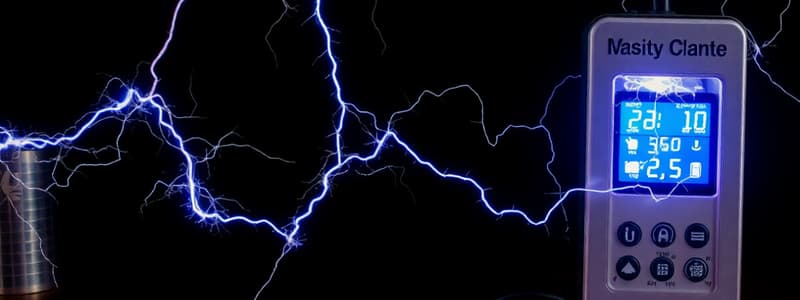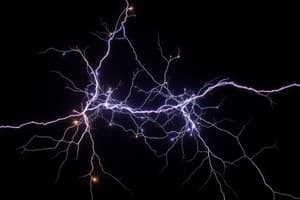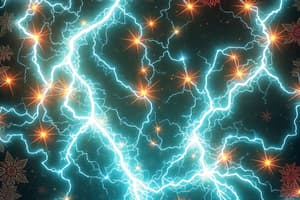Podcast
Questions and Answers
What is the atomic mass of Potassium?
What is the atomic mass of Potassium?
- 24
- 39 (correct)
- 19
- 56
Which group does Fluorine belong to in the periodic table?
Which group does Fluorine belong to in the periodic table?
- 1
- 2
- 14
- 17 (correct)
What charge does an electroscope receive when a positively charged object is brought close?
What charge does an electroscope receive when a positively charged object is brought close?
- -1 (correct)
- 2
- 0
- 866
Which of the following is a characteristic of a series circuit?
Which of the following is a characteristic of a series circuit?
What is the main difference between static electricity and current electricity?
What is the main difference between static electricity and current electricity?
Which substance pairs would likely induce the strongest charges when rubbed together?
Which substance pairs would likely induce the strongest charges when rubbed together?
How is voltage measured in an electric circuit?
How is voltage measured in an electric circuit?
What is the primary role of a conductor in an electric circuit?
What is the primary role of a conductor in an electric circuit?
Which of the following formulas corresponds to Sodium bicarbonate?
Which of the following formulas corresponds to Sodium bicarbonate?
What is the number of neutrons in Iron based on the atomic information provided?
What is the number of neutrons in Iron based on the atomic information provided?
What defines abiotic factors in an ecosystem?
What defines abiotic factors in an ecosystem?
Which of the following accurately describes biodiversity?
Which of the following accurately describes biodiversity?
Which term describes the role of a species in its environment?
Which term describes the role of a species in its environment?
What is the primary characteristic of a carnivore?
What is the primary characteristic of a carnivore?
What is one possible consequence of deforestation?
What is one possible consequence of deforestation?
What is the function of decomposers in an ecosystem?
What is the function of decomposers in an ecosystem?
How do invasive species typically affect native ecosystems?
How do invasive species typically affect native ecosystems?
What is the definition of cellular respiration?
What is the definition of cellular respiration?
Which component makes up the largest part of the biosphere?
Which component makes up the largest part of the biosphere?
What is meant by the term 'carrying capacity'?
What is meant by the term 'carrying capacity'?
What is the primary difference between series and parallel circuits?
What is the primary difference between series and parallel circuits?
Which method is primarily used to charge an object by friction?
Which method is primarily used to charge an object by friction?
What distinguishes conductors from insulators in an electric circuit?
What distinguishes conductors from insulators in an electric circuit?
How is current defined in the context of electricity?
How is current defined in the context of electricity?
Which of the following scenarios best exemplifies charging an electroscope?
Which of the following scenarios best exemplifies charging an electroscope?
What is the antagonist in the novel "Romeo and Juliet"?
What is the antagonist in the novel "Romeo and Juliet"?
Which literary work is set in an unnamed city during wartime?
Which literary work is set in an unnamed city during wartime?
In which novel does Jacob come to a crucial realization about his reality?
In which novel does Jacob come to a crucial realization about his reality?
Which of the literary works is set in multiple locations in Verona?
Which of the literary works is set in multiple locations in Verona?
What is a recurring theme found in both "Romeo and Juliet" and "The Tell Tale Heart"?
What is a recurring theme found in both "Romeo and Juliet" and "The Tell Tale Heart"?
Provide two examples of life lessons that can be learned from analyzing these literary works.
Provide two examples of life lessons that can be learned from analyzing these literary works.
Why are the notes considered to include personal reflection and insights about the literature?
Why are the notes considered to include personal reflection and insights about the literature?
Identify a key plot point that appears to be disliked by the note-taker, and provide a reason for their dislike, based on the content provided.
Identify a key plot point that appears to be disliked by the note-taker, and provide a reason for their dislike, based on the content provided.
What are the three core aspects of the Pascal Mystery?
What are the three core aspects of the Pascal Mystery?
What are the three Synoptic Gospels?
What are the three Synoptic Gospels?
What are the three categories of Sacraments in the Catholic Church?
What are the three categories of Sacraments in the Catholic Church?
What is the definition of 'discipleship' and how does it relate to the Bible?
What is the definition of 'discipleship' and how does it relate to the Bible?
Explain the significance of the Golden Calf story and how it reflects human nature.
Explain the significance of the Golden Calf story and how it reflects human nature.
What is the primary purpose of Prayer of Intercession?
What is the primary purpose of Prayer of Intercession?
In the Parable of the Mustard Seed, what does the mustard seed symbolize?
In the Parable of the Mustard Seed, what does the mustard seed symbolize?
How does the Prodigal Son parable define the concept of forgiveness?
How does the Prodigal Son parable define the concept of forgiveness?
What does the Symbol of the Lamp represent in teachings?
What does the Symbol of the Lamp represent in teachings?
List the first three parts of the Rosary.
List the first three parts of the Rosary.
Flashcards
Atomic Number
Atomic Number
The number of protons in an atom's nucleus, determining its chemical identity.
Atomic Mass
Atomic Mass
The total mass of an atom's protons and neutrons.
Electrons
Electrons
Negatively charged particles orbiting the nucleus of an atom.
Neutrons
Neutrons
Signup and view all the flashcards
Current
Current
Signup and view all the flashcards
Voltage
Voltage
Signup and view all the flashcards
Conductor
Conductor
Signup and view all the flashcards
Insulator
Insulator
Signup and view all the flashcards
Series Circuit
Series Circuit
Signup and view all the flashcards
Parallel Circuit
Parallel Circuit
Signup and view all the flashcards
Abiotic factors
Abiotic factors
Signup and view all the flashcards
Biodiversity
Biodiversity
Signup and view all the flashcards
Biosphere
Biosphere
Signup and view all the flashcards
Biome
Biome
Signup and view all the flashcards
Community
Community
Signup and view all the flashcards
Ecology
Ecology
Signup and view all the flashcards
Ecosystem
Ecosystem
Signup and view all the flashcards
Extinct
Extinct
Signup and view all the flashcards
Habitat
Habitat
Signup and view all the flashcards
Omnivore
Omnivore
Signup and view all the flashcards
Static Electricity
Static Electricity
Signup and view all the flashcards
Electric Current
Electric Current
Signup and view all the flashcards
Protagonist
Protagonist
Signup and view all the flashcards
Antagonist
Antagonist
Signup and view all the flashcards
Setting
Setting
Signup and view all the flashcards
Major Themes
Major Themes
Signup and view all the flashcards
Plot Points
Plot Points
Signup and view all the flashcards
Life Lessons
Life Lessons
Signup and view all the flashcards
Character Traits
Character Traits
Signup and view all the flashcards
Character Motivations
Character Motivations
Signup and view all the flashcards
What is a Sacrament?
What is a Sacrament?
Signup and view all the flashcards
What are the Synoptic Gospels?
What are the Synoptic Gospels?
Signup and view all the flashcards
What is a Miracle?
What is a Miracle?
Signup and view all the flashcards
What is Canonization?
What is Canonization?
Signup and view all the flashcards
What is Prayer?
What is Prayer?
Signup and view all the flashcards
Praise and Adoration
Praise and Adoration
Signup and view all the flashcards
Petition Prayer
Petition Prayer
Signup and view all the flashcards
Apostles' Creed in the Rosary
Apostles' Creed in the Rosary
Signup and view all the flashcards
Intercession
Intercession
Signup and view all the flashcards
Meditation Prayer
Meditation Prayer
Signup and view all the flashcards
Study Notes
Electricity Unit
-
Static electricity differs from current electricity. Static electricity involves a buildup of charge, while current electricity involves a flow of charge.
-
Charging by friction occurs when rubbing two different materials together causes one to gain electrons and the other to lose electrons.
-
Electrostatic series helps determine resulting charge of materials rubbed against each other (e.g., glass and silk). Glass gains a positive charge, and silk gains a negative charge when rubbed together
-
Charging by conduction involves transferring charge by direct contact, as in touching a doorknob after walking across a carpet.
-
The law of electric charges states like charges repel, and unlike charges attract. A neutral object has an equal number of positive and negative charges.
-
Electric circuits consist of four parts: a source (battery), a load (lightbulb), wires, and a switch, though not always required.
- Voltage is the energy given to electrons by the battery, measured in volts (V).
- Voltage in a series circuit is split among the loads.
- Voltage is the same in each path of a parallel circuit.
- In a series circuit, if one light bulb is unscrewed or burns out, the second light bulb will not light.
- In a parallel circuit, if one light bulb is unscrewed or burns out, the second light bulb will light.
- Current is the rate of flow of electrons, measured in amperes (A).
- Current in a series circuit is the same throughout the circuit.
- Current in a parallel circuit splits, with the total current equaling the sum of the currents in each path.
Chemistry Unit
-
Elements are identified by their atomic number, atomic mass, number of protons, neutrons, and electrons.
-
Bohr-Rutherford diagrams illustrate the atom's structure including protons and neutrons in the nucleus, and electrons in orbits (shells) around the nucleus. Atomic diagrams show the arrangement of these orbits.
-
Formulas for compounds are based on the ratios of atoms in a substance as in, for example, sodium bicarbonate(NaHCO3) and acetylsalicylic acid (C9H8O4).
Ecology Unit
-
Abiotic factors are non-living components of an ecosystem, e.g., sunlight, water, temperature.
-
Biodiversity is the variety of life in a particular habitat or ecosystem.
-
Biosphere encompasses all living organisms on earth.
-
Ecology studies the interactions between organisms and their environment.
-
Community is a group of organisms of different species living together in a particular area.
-
Extinct means a species no longer exists.
-
Ecosystem includes all living and non-living things, e.g., a forest, a pond.
-
Habitat is the natural environment of an organism.
-
Species is a group of organisms closely related and capable of interbreeding.
-
Food chains and food webs show how energy and matter flow through an ecosystem.
-
Trophic levels are feeding positions in a food chain, from producers to top consumers.
- Invasive species can damage ecosystems by outcompeting native species for resources.
- Producers are organisms that produce their own food, such as plants.
- Consumers are organisms that obtain energy by consuming other organisms.
- Decomposers are organisms that break down dead or decaying matter.
General Science
-
Photosynthesis is the process where plants use sunlight and water to produce their own food from carbon dioxide. The word equation for photosynthesis: Carbon dioxide + Water → Glucose + Oxygen.
-
Cellular respiration is the process in which organisms break down glucose to release energy. The word equation is: Glucose + Oxygen → Carbon dioxide + Water.
-
Biodiversity is essential to protect, as it supports many functions within the environment and ecosystem.
-
Some energy sources are non-renewable (e.g., fossil fuels), whereas others are renewable (e.g., solar).
Density Calculations
- Density is calculated using mass divided by volume (mass/volume), examples of such calculations are given in this image.
Studying That Suits You
Use AI to generate personalized quizzes and flashcards to suit your learning preferences.



